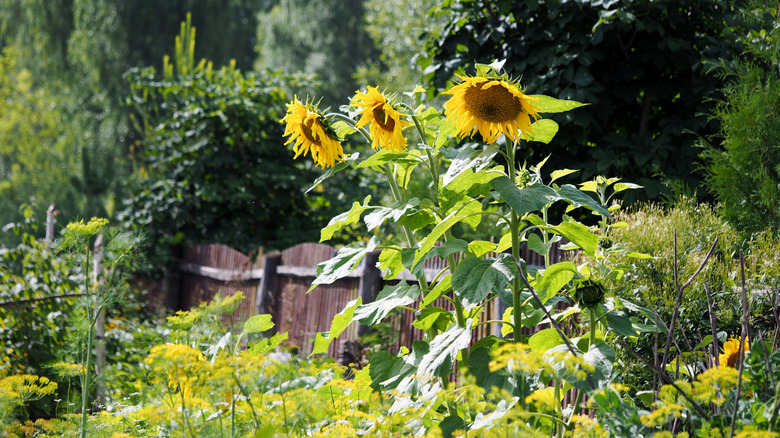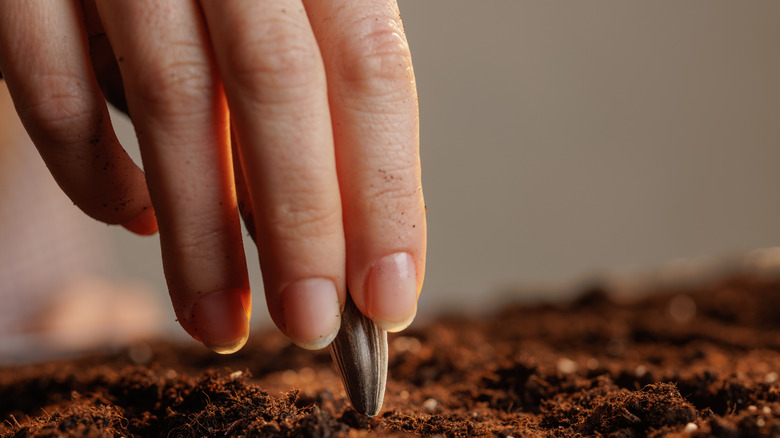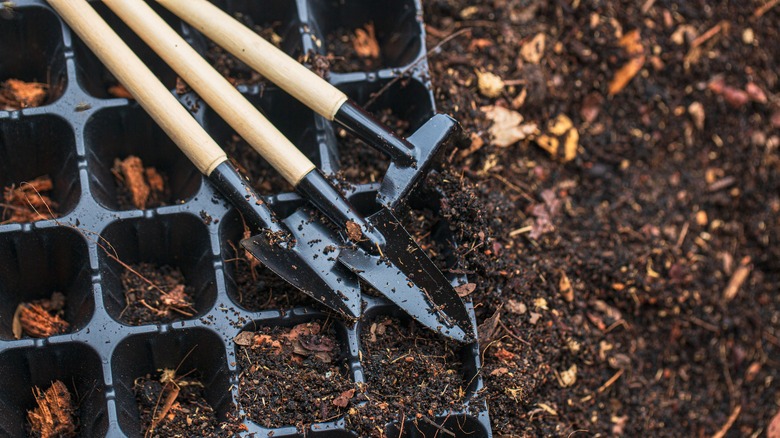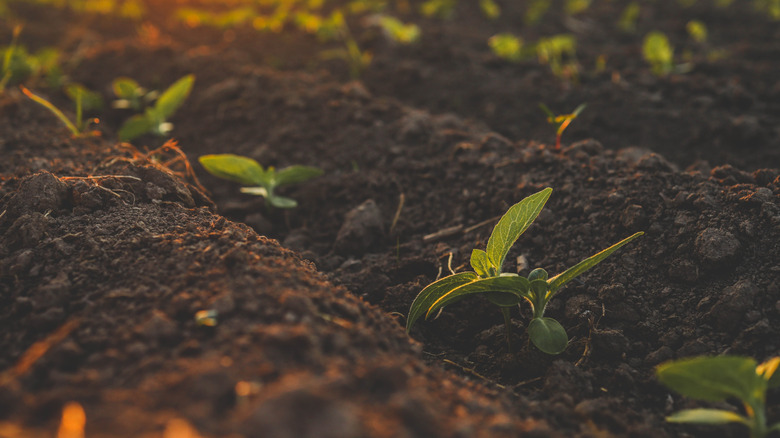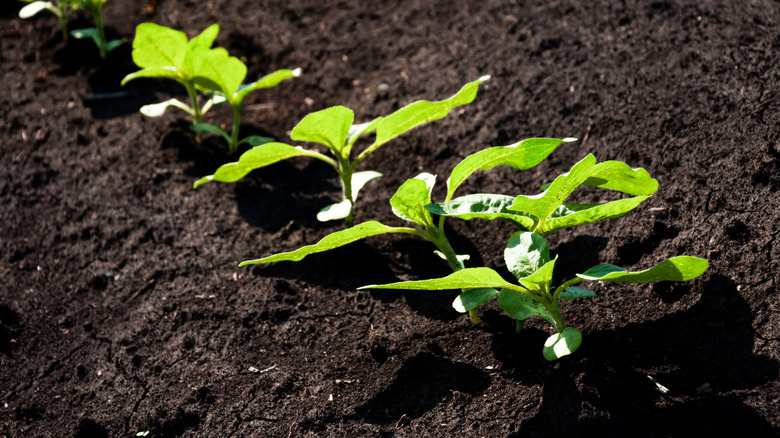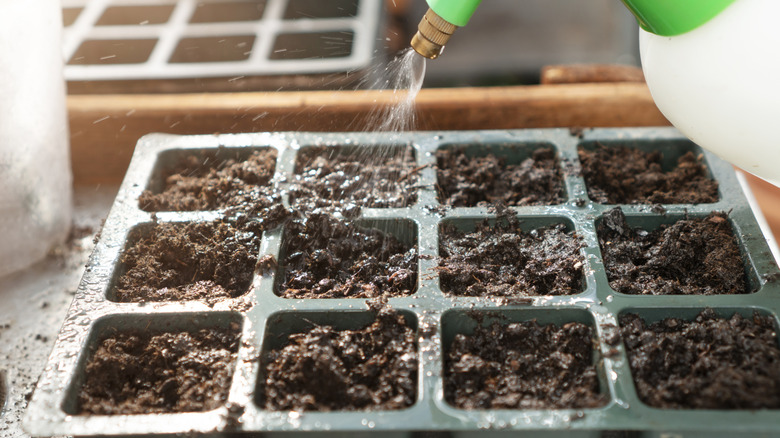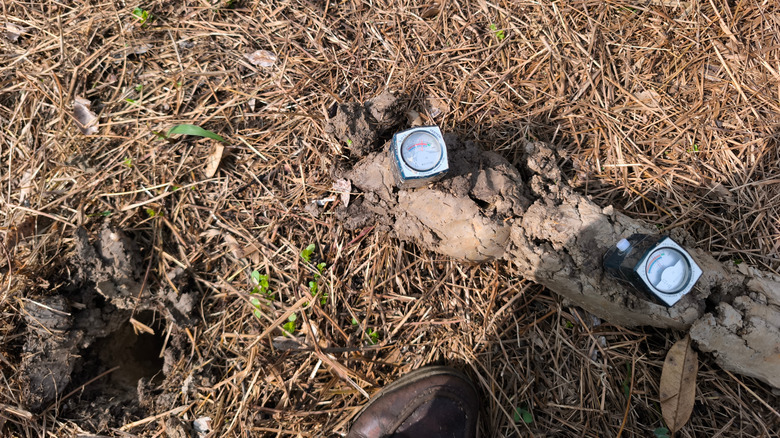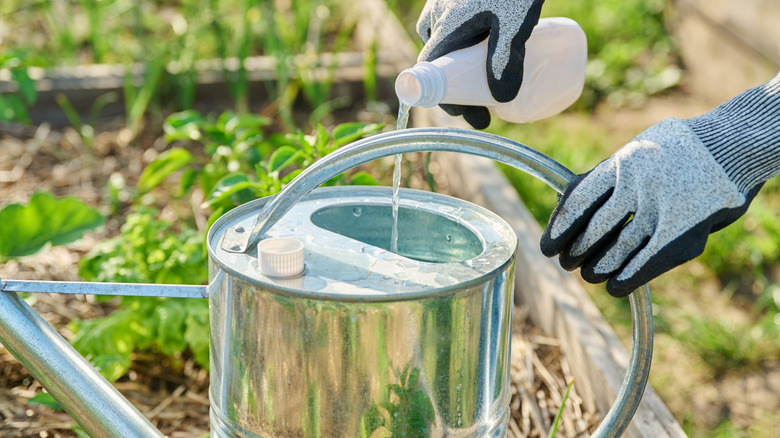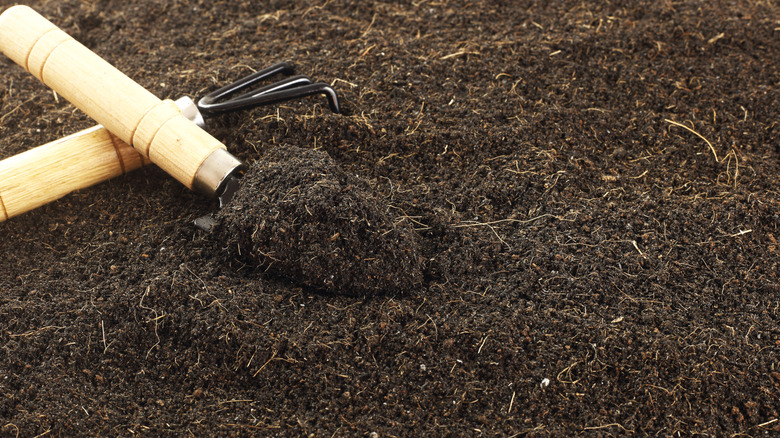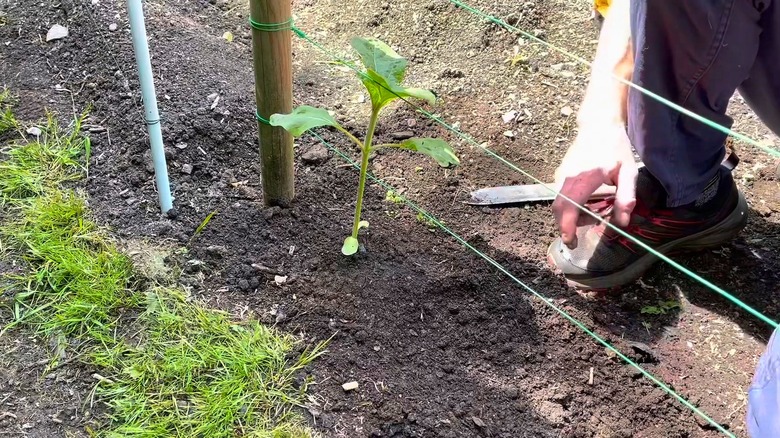Grow The Biggest Sunflowers With 16 Smart Tips
We may receive a commission on purchases made from links.
Sunflowers (Helianthus annuus) are often considered the perfect plant for beginner gardeners, but they can also be a subject of serious competition. Every year schools, clubs, and other community organizations across the country run sunflower growing contests. Whether you're looking to win a prize for the tallest sunflower — or simply want the thrill of having a few giant specimens gracing your yard this summer — we've rounded up some crucial tips.
Depending on the type you plant, as well as the overall growing conditions, sunflowers can get up to 15 feet tall. If you want big, behemoth sunflowers on the taller end of this spectrum, you need to provide them with the right conditions to ensure they can grow to their full potential. To reach max size, sunflowers need to be planted at the right time, get a goldilocks watering schedule, and, very importantly, additional support as they get taller. With these and more tips below, you can enjoy the biggest, most show-stopping sunflowers possible.
For maximum height, choose giant sunflower varieties
There are nearly 70 different varieties of sunflowers, and they vary vastly in height. While it's possible to maximize the growth of your sunflowers, you can only do so much if you're working with a non-giant cultivar. And you definitely don't want to erroneously select cultivars that rank among the shortest, such as 'Ms. Mars,' 'Sunspot,' or 'Teddy Bear.'
To get truly towering results, stick with "giant" varieties only. You can start by checking out these varieties of the tallest sunflowers you can grow in the garden. When planted and grown with care, such cultivars can reach up to at least 8 feet tall. Common examples of giant sunflower cultivars include 'American Giant,' 'Cyclops,' and 'Mammoth.' Of these, 'Mammoth' is considered the most commonly grown giant sunflower in residential areas, and it can grow more than 12 feet tall. 'Mammoth' cultivars are not only popular for their height, though. These plants are known for their cheerful yellow blooms that can also attract native pollinating species such as butterflies and birds. As a bonus, this cultivar is considered deer-tolerant, too.
Consider sowing sunflower seeds directly into the ground
When it comes to planting sunflower seeds, you generally have two options. You can technically start growing any sunflower variety indoors and transplant them into the ground later in the season when ground temperatures warm up. However, giant sunflower varieties may grow better when you sow their seeds directly into the ground. Transplanting giant sunflowers can be an especially tricky endeavor because it can disturb their long tap roots. One false move, and you could accidentally stunt their post-transplant growth. Even if you get them into the ground without disturbing their taproots at all, transplanted sunflowers might still be apt to grow slightly shorter than if directly seeded.
Consider sowing your giant sunflower seeds directly into the ground. Doing so will help ensure the roots have the space to quickly grow without any disruption. Prep the area in your garden a couple of weeks in advance of your designated sowing date for best results, and plant the seeds as soon as the last danger of frost has passed.
If you do start the seeds in pots, don't be tardy with transplanting
While direct sowing is preferable, it is possible to transplant giant sunflower varieties. This might be a better option if seed-digging pests, such as squirrels and chipmunks, are a problem. Here's how to reduce the chance of stunting your transplants: Aside from taking care with the long taproots, you'll also need to make sure you don't leave them in the seedling tray for too long. Planting out the sunflowers promptly means the seedlings won't get root bound, and reduce the chances of transplant shock – which can both trigger stunted growth.
For best results, plant two seeds in each slot of the planter tray. On average, sunflowers start to germinate within 3 to 8 days, and will usually begin to outgrow their indoor planters within 2 weeks. You can transplant your giant sunflower varieties within this 2-week timeframe, but be sure to place the trays outside a few days ahead of transplanting to harden off the seedlings.
Don't wait too long to plant them
Timing is crucial when planting sunflowers. As a general rule of thumb, you'll want to wait until all frost dangers are over in your area before sowing sunflower seeds or transplanting seedlings you've grown indoors. The rules get a little more complicated with giant varieties, though. Some cultivars, such as 'Mongolian Giant,' can take between 90 and 100 days to mature, so it's also important that you don't wait too long to plant them. Also, waiting to plant sunflowers until the mid-summer months may trigger shorter stalks.
To figure out your last frost date, you can use this frost date calculator from the National Gardening Association and enter your zip code. To be on the safe side, you can also wait to plant your giant sunflowers until the daytime and nighttime temperatures in your area both exceed 50 degrees Fahrenheit. If an unseasonably late frost is due to hit, be sure to cover your sunflower seedlings with a frost blanket (like these Yffsidmy Plant Covers), or even a cardboard box.
Ensure adequate space between each plant
Another sunflower growth factor has to do with the amount of spacing you give each plant. Giant sunflower varieties have larger root systems and require more room to grow. Typically, planting giant sunflowers too close together will result in stunting and reduced height. Sometimes, slight crowding can result in taller stalks, but you'll probably get smaller heads — which won't further your goal of growing massive sunflowers.
Most types of sunflowers need about 2 to 3 feet of space between each row. Within your row or bed, aim to ultimately space giant sunflowers about 18-20 inches apart. If you're sowing seeds directly, start out by spacing them 6 inches apart. In about 2 weeks, once the seeds have germinated and grow a couple sets of leaves, you can then thin out the rows (removing the smaller, weaker seedlings), to create an 18-inch gap between plants. Alternatively, if you're just looking to grow a single giant sunflower, and don't want to create rows, sow a few seeds in a patch, and then slowly thin them out until you're left with one strong plant.
Giant sunflower seeds need frequent watering
Sunflowers have a reputation for being pretty drought-tolerant. But this rule only applies once they are established, and their extensive, branching root system has developed. It doesn't mean that sunflowers need no water, especially during the early planting and germination stages. On the contrary, sunflower seeds need frequent, light watering sessions to support germination and sprouting. Underwatering seedlings can cause stunting, which is the last thing you want when trying to grow show-stopping, towering sunflowers.
Sunflower seeds need watering every single day during the first week and up to 10 days after planting. The soil around sunflower seedlings should be kept moist at this stage. Avoid over-soaking the soil, and don't allow it to completely dry out, either. After germination or transplanting, you may be able to taper down watering sessions to every few days, depending on rainfall. If you're experiencing a drought, you might need to water them more frequently than this until the plants are established.
Established giant sunflowers still require a watering schedule
Besides frequent watering during germination and establishment, you may also need to give your giant sunflowers supplemental irrigation as they mature. Just because established sunflowers can tolerate drought doesn't mean that they'll thrive if deprived of water. Without adequate water, drought stress may set in, which can reduce the height and overall mass of sunflowers by up to 50% (as per a 2024 study published in BMC Plant Biology). Giant cultivars in particular need extra water to encourage a strong root system that will support the plants, and can struggle to bounce back after wilting. It's also important to water when fertilizing, otherwise your sunflower plants might not be able to uptake the nutrients they need to grow big and tall.
You can tell whether the topsoil is too wet or too dry simply by feeling it. Be sure the soil is completely soaked during watering, and allow it to dry slightly between sessions. Most established sunflower plants need about an inch of water per week, and to properly soak the root zone of giant varieties, this can require a few gallons of water. Continue watering giant cultivars 20 days after they flower to support larger heads. On the flipside, too much water is a common mistake to avoid when watering your garden, as it can lead to root rot and other diseases — so monitor the soil to make sure you're not continually oversaturating it.
Ensure robust growth with full-sun conditions
Sunflowers require full sun (in other words, a minimum of 6 hours of direct sunlight per day). To give you an idea of how reliant they are on direct sun exposure: A 2024 study published in the Physical Review X journal showed that sunflower plants grown in proximity to each other actually have a development mechanism that enables optimized light exposure for all the collective plants. In other words, they grow in tandem to ensure the maximum amount of sun gets to as many plants as possible. As your giant sunflowers grow, their heliotropic qualities will also become quite obvious. You will be able to see the young heads track the sun from east to west. In addition to light, warm conditions also help ensure flower development.
To ensure the growing potential of your giant sunflowers, choose a spot that receives 6 to 8 hours of direct sunlight exposure each day. You can either observe your garden through the day, or use a sunlight calculator like the Luster Leaf Rapitest Suncalc. Bonus tip: If you're eager to admire a show of massive sunflower heads while sitting on your porch or deck, try to choose a spot where you can be sure they'll face into your yard or garden, and not out of it, while tracking the sun.
Make sure you adequately amend the soil with compost before planting giant sunflowers
Preparing the site of planting with adequate organic matter amendments can ensure the soil is loose, light, and has enough nutrients to support sunflower growth potential. First, sunflowers prefer a pH level of 6 to 7, so you should test your soil before planting them to ensure the right acidity is available. You might consider a product such as MySoil Test Kit ProPack to check the nutrients of the area before you plant giant sunflowers. Fall is generally the best time of year to test soil quality, but spring tests can still be helpful.
Adding compost or other organic matter will not only provide nutrients, but also help to improve the soil's structure. In heavy soils, compost can increase drainage, and in sandy soils it's key for improving water retention. Amending with compost will also lighten heavy soil. Heavy, compacted soil can result in stunted vegetative development in sunflowers, so do not skip this step if you're planning to grow a super tall specimen. Aim to combine compost with soil ahead of time to ensure the pH isn't too high for your sunflowers. Add between 3 and 4 inches of the desired compost into your soil and combine well before you begin planting.
Feed your giant sunflowers through the growing season
Giant sunflower varieties have even more nutritional needs due to their larger sizes, and may need fertilizer support throughout their entire growing season. Consider an all-purpose fertilizer containing a 5-10-5 NPK ratio for sunflowers to start. If soil testing reveals deficiencies in nitrogen, phosphorus, or potassium, you can then adjust accordingly with a different fertilizer. To ensure larger flowers and taller sunflower plants, add the fertilizer after they produce their second set of leaves, and work it at least 8 inches into the soil. Avoid applying liquid fertilizer on sunflower stems, and be sure to dilute the product before pouring around the plants. Also, keep in mind that too much fertilizer may reduce flower growth in the long run.
You can use either liquid or granular fertilizers. If you want to put your sunflowers on a continual feeding program, one option is to apply several gallons of diluted liquid fertilizer every week as they start to get tall. Creating a moat around each plant can also help to ensure the nutrients reach the roots, and don't run off into other areas of the garden. You can do this by digging an 18-inch trench around the plant, ensuring that it's also 4 inches deep. Another option is to apply slow-release granules directly into the soil at the beginning of the growing season and then reapply according to the package instructions.
Make sure you pick a planting location that has good drainage
Giant sunflowers require well-draining soil to thrive. Their reputation for drought-resistance is attributed to their branching roots that have the ability to extract moisture deep from within the soil. When planted in a spot that consistently gets waterlogged, your plants could be robbed of their growth potential. Poor-draining soil can lead to both root and stalk rot.
Always make sure that your giant sunflowers are planted in a well-draining location. If you know there's an area in your yard or garden that tends to puddle long after it rains, you should not plant these flowers there. A moisture meter, such as the XLUX Soil Moisture Meter, can allow you to check moisture levels below the surface.
Support giant sunflowers with stakes
Generally, staking is not required for many types of sunflowers, particularly when you're planting dwarf varieties. When you have giant cultivars though, staking them can help to prevent the tops from drooping over, particularly during inclement weather. Also, the larger your sunflower heads get, the more stress this will place on the stems. Stakes also help support continued growth to ensure your sunflowers will make it to their maximum height range.
To stake your giant sunflowers, you will need to drive the stakes firmly into the ground. You can create a lattice-like structure, or tie the sunflower stems directly to the stakes with a small amount of twine. Be sure the tie is secure enough to keep the plants upright, but not so tight that it will interfere with the health of the stems.
As an alternative to stakes, try supporting giant sunflowers with T-posts or a trellis
Trellising is another way to support giant sunflowers (and ensure they don't break under the weight of the flowers). You can buy a premade trellis from a garden center, or create your own with posts sunk into the ground and wire or twine running between them. Creating your own trellis system will probably be the more practical option if you're growing sunflowers out in the open. A bought trellis on the other hand can be an easy solution if the sunflowers are growing against a wall or plank fence.
To get started, you'll first want to select some tall posts. T-posts (which many gardeners use for trellis structures) come in a range of 3 to 12 feet long. Wire can work well for the lines running between the posts. If you tie your sunflowers to this wire, select a soft material such as twine, cotton, or jute.
Consider planting giant sunflowers against a south-facing wall or fence
Sunflowers become top-heavy as they get taller, which can be a particular problem for giant cultivars. Aside from the added weight of their flowers, these plants can also become victims of wind. Besides providing support with stakes, planting giant varieties in a sheltered, south-facing position can help to safeguard them from strong winds.
South-facing walls can offer protection, but if you don't have an open border bed on the south of your house, you can also plant giant sunflowers against a fence facing towards the south to offer a layer of protection from wind damage. Another option is to plant them near a shed, or other structure in your yard.
Manage possible fungal diseases early to prevent stunted sunflower growth
Sunflowers might be tough, but they aren't completely immune to problems. These plants are still vulnerable to diseases, especially fungi. Examples include downy mildew, powdery mildew, rust, and leaf spot that can wreak havoc on your plants. If a fungal disease happens to impact your giant sunflowers, it will eventually spread through the entire plant. Not only will this stunt their growth, but fungal infections can be deadly, too.
Use a garden fungicide to treat any of the affected plants as soon as you see possible signs of fungal disease, such as unusual spots on the leaves, or leaves that are shriveled up entirely. Make sure to follow all package instructions. Avoiding too much water and encouraging airflow between plants can also help prevent fungal diseases in your giant sunflowers.
Keep a close watch for insect problems in the stems
If your sunflowers are well-supported and watered, but are sagging, another problem could be at play. Sagging flowers can indicate stem weevils and stem borers. These pests can get inside your giant sunflower stems and weaken them, leading to sagging, breakages, and overall compromised plants.
To determine whether insects have targeted your sunflowers and caused sagging, look for holes or cut into parts of the stem. If the interior of the stems are brown-colored and have a mushy texture, chances are you have problems with these pests. (You may even see the pests hanging out inside the stems directly!). Cut down any affected plants, destroy the stems, and make sure there's enough space and airflow between other sunflower plants to prevent further infestations.
